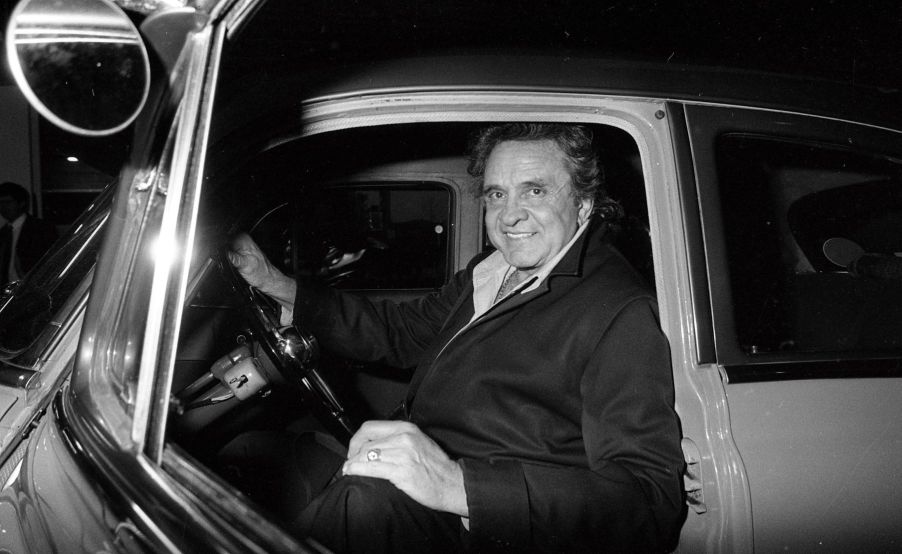
Johnny Cash ‘Got Really Sick of’ Building Pontiac Cars After Only 3 Weeks
It’s not uncommon to hear about celebrities owning cars, whether they are costly ones or your average cheap vehicles. However, it’s not all that often you hear about famous people working at automotive plants, but one popular singer once did. Johnny Cash built Pontiac cars for a brief period in his youth. How did his music career start, what cars did he help make, and what plant did he likely work at?
Johnny Cash’s musical career

Johnny Cash was born in Kingsland, Arkansas, in 1932. His parents were Baptist sharecroppers, and he was one of seven children in the family. They often spent hours working in the fields together, and music was a way to pass the time and release stress. By age 12, Cash was writing his own songs.
His mother, who recognized that he had talent, saved up some money so that he could take voice lessons and develop a career in music. After about three sessions, Cash’s teacher told him to quit taking lessons and keep his natural singing voice, which ultimately kickstarted his career later on.
In 1954, he partnered with the Tennessee Two band and auditioned for Sun Records. While the producer didn’t like the gospel style they sang, he was still interested in signing them on at the company, so the band was asked to come back with an original song, which they did. They ended up recording Cash’s “Hey Porter” and “Cry, Cry, Cry” songs around 1955.
According to Biography, Cash would continue writing music and recording albums until his death in 2003. Some of his most popular ones included Johnny Cash at Folsom Prison, American Recordings, and American IV: The Man Comes Around.
Johnny Cash’s job working at Pontiac’s Fisher plant
Johnny Cash spent a good part of his life in music, but he did work a few odd jobs here and there during his lifetime. One notable position was his brief stint at the Fisher plant. When he was 18 years old, he left home, hitchhiked to Pontiac, Michigan, and was hired on by Fisher, making 1951 Pontiacs, according to an NPR interview. “I worked there three weeks, got really sick of it, went back home and joined the Air Force.”
While the interview doesn’t specifically say which vehicles he would’ve worked on at the building, it can be assumed, during that time frame, that it was likely either the Chieftain De Luxe line or the DeLuxe Catalina. Both were the most popular of the day, but Pontiac also had a Streamliner Coupe made there.
The Chieftain De Luxe came in a four-door sedan, a two-door sedan, and a convertible with two doors. There was a Chieftain De Luxe sedan and coupe as well. The Catalina model came in De Luxe and Super De Luxe. Pontiac’s Catalina went on to inspire a muscle car in the 1960s.
Pontiac’s 1951 models would’ve come with either a straight-eight engine producing 116 horsepower, mostly seen with the more expensive cars, but not with Pontiac. Or you could choose an economical six one that would generate 96 hp. They also came with cushioned seats, Hydra-Matic drive, Flex suspension springs, and wide access doors, according to Motorologist.
A brief overview of the Fisher Body Company
Albert Fisher and his nephews built the Fisher Body Company in 1908 and specialized in building bodies for automotive industries and carriages. In 1911 they dropped the carriage line and stuck with producing vehicle bodies instead, which were made from a mixture of metal and shaped wood at the time.
By 1910, they were building bodies for big-name companies like Cadillac, Studebaker (who also had a history in carriages), Ford, and Hudson. Over the years, they expanded to 40 different buildings producing these automotive bodies, and plant #21, the one Cash likely worked at, was built in 1919, located in Detroit, which wasn’t far from Pontiac. This is where some of General Motors’ products would’ve been produced.
According to Detroiturbex, when the second world war hit, the Fisher Body Plant had to revamp its production and focus on military products, like planes, tanks, and anti-aircraft guns, along with a few other materials. Not long after that, it returned to vehicles, which it produced for GM for many years until 1984, when GM shut it down. It was picked up by an industrial painting company for a few years but closed its doors by 2000 and has been basically empty since.
The slogan of Fisher was “Body by Fisher,” which was used to designate the products the company churned out for its customers. Back in the company’s early days, bodies had a modular passenger compartment instead of the chassis we’re familiar with today. Those compartments could be switched out with others to form different styles to suit the tastes of the customer contracting with Fisher. So, automotive flyers for vehicles would add “Bodies by Fisher” as a sort of car feature.
Johnny Cash enjoyed one of the longest music careers of any singer in decades. While he spent most of his life singing, writing music, and strumming his guitar, he still had a short stint building cars at one of the Fisher plants before getting sick of doing it. While we don’t know if that short period of his life impacted his music, we can certainly hope it did.


